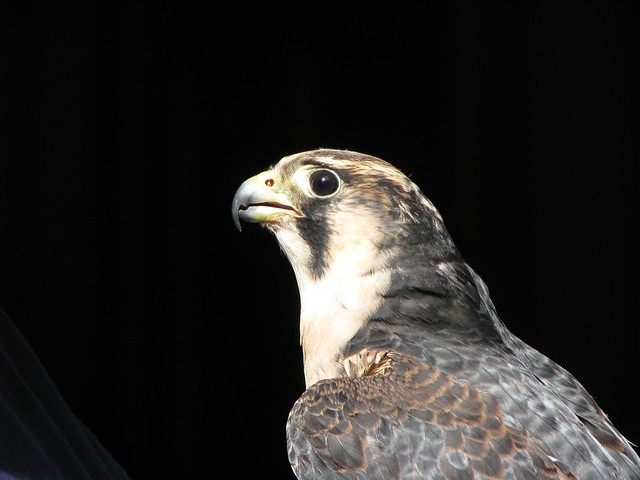I've written here before about my occasional work with the
Indiana Raptor Center, helping spread the word about conservation and rehabbing injured birds of prey so we can keep this proud branch of the dinosaur family going strong. There's been a bit of activity lately, so I figured I'd round it all up in this post.
Vulture Rescue Squad!
 There's a vulture in there, honest!
There's a vulture in there, honest!
This week, I visited the center to talk shop and hammer out some details about a couple of design projects, detailed below. As soon as I pulled in the driveway, they had a surprise for me: my first rescue trip. A nearby landowner had reported a turkey vulture with a broken wing. Center founders Patti Reynolds and Laura Edmonds weren't sure if it was a good ID; wild turkeys are sometimes confused for vultures. But we had to go check it out.
We bounced up and down the hills and dales of Brown County, and after several minutes were at the location. We found that the ID was good: it was a small Turkey Vulture, with an obvious wing injury. Volunteer and master taxidermist Marcus donned some heavy gloves, Patti grabbed a towel, and I took a large net, with my camera hanging from my neck. Forming one point of an enclosing triangle, it was my job to keep the vulture out of the road. Patti and Marcus approached from their points, and within five minutes of us pulling up, Marcus lunged, pinned the bird, and scooped him up. Patti wrapped him in her towel.

Luckily for the bird, he had managed to scrounge some nutrition. Luckily for us, it hadn't been too recently. The vulture tried to defensively vomit, but since he had an empty tank, we kept clean. After a chat with the homeowner about the bird's possibilities for rehab, we delivered him to the Raptor Center's facilities where Laura was ready to do an evaluation.


He had a pretty bad break right at his wrist joint (seeing vulture pus is marked off my bucket list), which Laura cleaned and wrapped. After hydrating him and feeding him raw beef dipped in gatorade, she gave gave him a shot of painkiller and returned him to his box for a much-needed nap. Next, he'll visit their veterinarian who will determine the chances for recovery, and his ultimate fate will be decided. If the wing can be healed, he'll eventually be released. If not, he'll have to be euthanized. Fingers crossed for a good prognosis.
 UPDATE:
UPDATE: Sadly, the bone was too far gone and the bird had to be euthanized. He is going to be mounted for a local nature center's educational programs. But I'll always remember him like so: a creature joyful to be fed fresh meat, whipping it back and forth in his beak and spraying us with gatorade. To a second life as a teacher of curious minds.
Conserving a Jurassic Legacy
I'm always excited to work in a new production medium, and when Laura recently asked me to think about a design for a patch depicting a Mesozoic dinosaur with an extant bird of prey, I was stoked to work on it. I recently submitted this design of
Velociraptor and a Red-tailed Hawk, which everyone at the Raptor Center gave the thumbs up to... next step is production. I'll be talking to a manufacturer to find out if I need to tweak anything to make sure the small detail is preserved once it jumps from screen to thread. I cannot wait to get the embroidered final product. I'll snap some photos for sure.
 Red-Tailed Hawk Conservation
Red-Tailed Hawk Conservation
We've had a rash of protected bird shootings in Indiana over the last several months. Luckily for our birds, Patti and Laura know that a method to combat this has been tried and proven in other states: simply, put birds in front of school children and get the population of outdoorsmen to pay attention. I'll be helping with both efforts, but first up I'll be doing a poster aimed at the latter group. I'm really excited that we've received permission to use one of
William Zimmerman's Red-Tailed Hawk paintings! My task: to drive home the point that while a hawk will occasionally nab a chicken or two, your friendly neighborhood raptors save you thousands of dollars in the long run by eating up the rodents that covet your grain stores. I'll share this here as well.
Birds are dinosaurs, blah blah blah...



